Marking the Trail for OER/ZTC: Cañada College’s Journey in the ZTC Landscape, Spring 2021-Spring 2025
Sarah Harmon
From Spring 2021 through Spring 2025, Cañada College has enrolled 32,077 students[1] in zero-textbook-cost (ZTC) and low-textbook-cost (LTC) courses. The vast majority of these course sections are ZTC, which use any combination of open educational resources (OER), library subscriptions and databases, instructor-created materials and other publicly-available materials, with a strong preference among Cañada’s faculty to use OER textbooks and homework platforms. These ZTC and LTC courses have saved students an estimated $3,027,030[2]. In Spring 2025, Cañada College has 169 sections of 109 courses that are officially ZTC, and 19 sections of 10 courses that are officially LTC, which represents 40% of the total schedule[3]. The same semester saw 85 unique faculty teaching ZTC and LTC sections, with most faculty choosing to teach all of their sections as one or both of those designations. That represents 40.67% of the faculty teaching for that semester.
How did Cañada College get to this point? This case study will describe the trail that the faculty, classified staff, and administrative leadership created to get to this point. The hope is to create one possible map for colleges to follow in their OER/ZTC journeys. While this case study does not provide all the answers and it will become clear that the college still has gaps that it needs to address, the goal is to document the trail that the college took as an example of what can be done.
About Cañada College
Overlooking the San Francisco Bay, Cañada College is situated in Redwood City, California, part of the San Francisco Bay Area. It is one of three colleges in the San Mateo County Community College District (SMCCCD), along with the College of San Mateo and Skyline College. Prior to the arrival of the Spanish, the land upon which the college sits was part of the aboriginal home of the Ramaytush Ohlone, the original peoples of the San Francisco Peninsula, whose legacy and on-going contributions to the College and the community are acknowledged in our land and labor acknowledgement.
Cañada College offers over 50 associates degree programs, most of which are directly transferable to the California State University system; most of these programs also directly transfer to the University of California system and a wide array of private colleges and universities. For the time period that this chapter covers (academic years 2020-2021 through 2024-2025), the headcount ranged from 9,063 to 11,745, although the vast majority of students are either part-time (26.5-29.1%) or less than part-time (61-63.5%)[4].
Starting the ZTC Trail at Cañada College
Leadership
Zero-textbook cost efforts started at Cañada College in January 2019 when the Academic Senate for the California Community Colleges (ASCCC) and its OER Initiative (OERI) created college liaison positions (OERL) for each community college in the system. Cañada nominated their first OER Liaison at that point. This liaison brings news and information to the college’s Academic Senate, also reports to the ASCCC OERI on the work being done at the respective college[5]. At the outset, the Cañada College Academic Senate identified that this OER Liaison would be the OER Lead for the campus. The Academic Senate also identified a need to create a ZTC Adopters Program in order to provide training and professional development to faculty who were interested in adopting, adapting and remixing OER and other ZTC materials for their courses, using the Skyline program as a model. Cañada created an OER/ZTC Coordinator position in the faculty in order to lead these efforts; the position started in Fall 2020 with 20% release time awarded to do this work; this position would also serve as the OERL. As the San Mateo County Community College District (SMCCCD) created its Free College Initiative and budgeted funds for each of the 3 colleges in the district to perform ZTC work, the OER/ZTC Coordinator position increased in release time to 50% starting Fall 2022. This increased release time allowed the OER/ZTC Coordinator the latitude to perform outreach to faculty and to students, collect and analyze data, and work with the supervising dean to create a budget for the program.
Planning and Participatory Governance
From the outset, the OER Coordinator has worked with faculty, classified staff and administration to interweave OER/ZTC work throughout the campus. The goal has been to create a sustainable model that is both flexible and proactive to the needs of the students and of the college as a whole.
The OER/ZTC Coordinator chairs the Textbook Affordability Subcommittee (TAS) of the Cañada College Academic Senate. This subcommittee plays a vital role in connecting faculty and the campus community who are involved in instructional materials. Since its creation in Fall 2020, the TAS has provided guidance and feedback to the OER/ZTC Coordinator on the ZTC Adopter Program, participated in the creation of surveys and the analysis of the collected data, and created workshops to connect faculty with the professional development needed to support ZTC-based projects.
An additional foundational source came early in Cañada’s ZTC efforts, courtesy of the Regional Leaders of Open Education (RLOE). This program was created by Open Education Global as a means to support OER lead faculty in the creation of open education programs. Cañada’s OER/ZTC Coordinator and one of its full-time librarians participated in the program’s first cohort in Fall 2021. The end product of RLOE is an open education strategic plan; the Cañada faculty used that strategic plan to create the first OER/ZTC Implementation Plan for Cañada College. This plan laid out a series of benchmarks that became incorporated into two strategic initiatives of the college’s 2022-2027 Educational Master Plan.
Tracking of ZTC and LTC Courses
ZTC and LTC course marking has been done in SMCCCD since 2018; Skyline College was part of the second cohort of the California ZTC Pilot Project and started marking ZTC and LTC courses in the public online course schedule. When Cañada College decided to formally join in this work in Fall 2020, they decided to follow the same process and definitions that Skyline College had already instantiated, thereby creating a streamlined process across the district. The initial definitions required that ZTC courses have instructional materials that were free-of-cost to students; LTC courses were those for which all required instructional materials for a section totaled $40 or less as new at the campus bookstore. The definitions of ZTC and LTC were formalized as a district in March 2022, in accordance with California Education Code, Title 5, Section 60010 and local definition of LTC. The definition of an instructional material is described by the education code cited above as including textbooks, homework platforms and lab manuals; they do not include supplies (including lab kits or art supplies) or technology required for the course, nor assessment materials (e.g. notebooks, test booklets, bubble sheets).
The tracking of ZTC and LTC courses at Cañada College starting in Spring 2021, with an initial two courses being reported. From the initial efforts in the 2020-2021 academic year, a more formalized process was created to ensure accuracy in the reporting of textbook adoptions and the use of ZTC and LTC materials. As a result, the numbers of ZTC and LTC courses has increased steadily with each term. This is discussed in more detail in “Addressing Enrollment” below.
The OER/ZTC Coordinator works with faculty to have their course sections marked as either being LTC or ZTC. Upon the final draft of the course assignments, this person connects with faculty in numerous disciplines directly to verify whether ZTC or LTC materials are being used. Outreach is done with other faculty teaching sections of courses that have already been converted to ZTC or LTC to spread the use of these materials. Additionally, the coordinator works with the Bookstore Manager to cross-check adoption reporting, thereby capturing other potential ZTC and LTC sections. Finally, the coordinator works with Division Assistants of the instructional divisions to ensure proper marking of ZTC and LTC course sections in the public online schedule. This process is regularly reviewed by all parties involved to identify gaps and address needs as they arise.
The data presented in this case study starts with Spring 2021 and runs through Fall 2023, when the OER/ZTC program was required to submit a program review report. There is additional information from Spring 2023-Spring 2025 with respect to enrollment and course and section numbers. Ongoing analysis on retention and success data from Spring 2023 onwards is currently being done, but is not available at the time of publication.
First Student Voice Survey
After two years of expanding the program, the TAS developed and ran a student survey and a faculty survey to identify areas of strength where the OER/ZTC program was thriving, as well as challenges and gaps that were either known or unknown. Both surveys ran in the Fall 2022 semester. While the faculty survey yielded expected results (particularly, overall support for the program but a desire for increased funding), the student survey offered important insights to the experiences of students in ZTC and LTC courses.
The student survey went out to all students enrolled in the 105 sections of ZTC and LTC students. While there were 2,280 students enrolled in ZTC and LTC courses that term, the survey garnered 100 full responses, with another 23 completing at least 50% of the survey and whose responses were included into the data. The survey consisted of 27 questions about various aspects of their interactions with course materials and the cost of instructional materials overall, plus areas where they could offer suggestions or ideas to improve the experience. An additional seven questions asked for demographic information and their access to technology. Twenty percent of the students who submitted the survey were enrolled in more than one ZTC/LTC section.
Upon reviewing the data from the student survey, the TAS focused on the following areas of inquiry.
Devices used
The TAS wanted to understand how students were interacting with their course materials. One hundred eleven of 114 total respondents indicated that they use a laptop or desktop, while only 57 respondents said that they use their smartphone. The TAS was expecting a higher response of smartphone users, based on anecdotal data. Twenty of 114 respondents used paper or print copies; this low number indicated to the TAS that more effort should be put into raising awareness of purchasing an optional print copy of OER-based materials at the campus bookstore. These data can be seen in Figure 1 below.
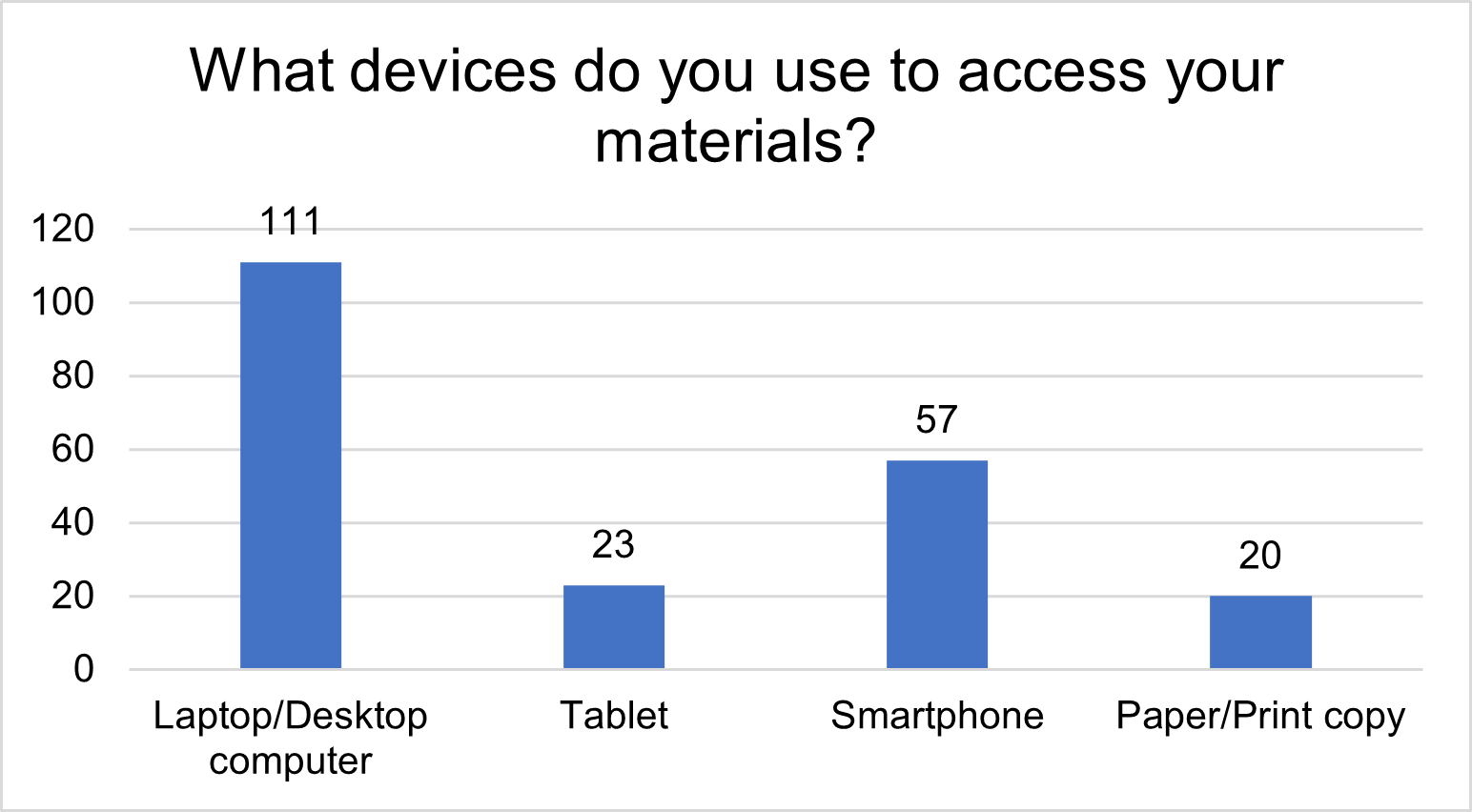
Note taking
One of the main anti-ZTC comments by faculty at the time was that students would not be able to easily take notes or turn in reading notes for their courses. The TAS decided to ask how students were taking notes; 89 of 113 indicated that they hand-wrote notes in a notebook, with another 47 indicating that they typed their notes into a document (e.g. Word, Google Docs); only 18 indicated that they used a note-taking application. The TAS saw this as proof that students were still actively taking notes using the digital materials, an interesting counter to the faculty argument against the use of ZTC materials. These data can be seen in Figure 2 below.
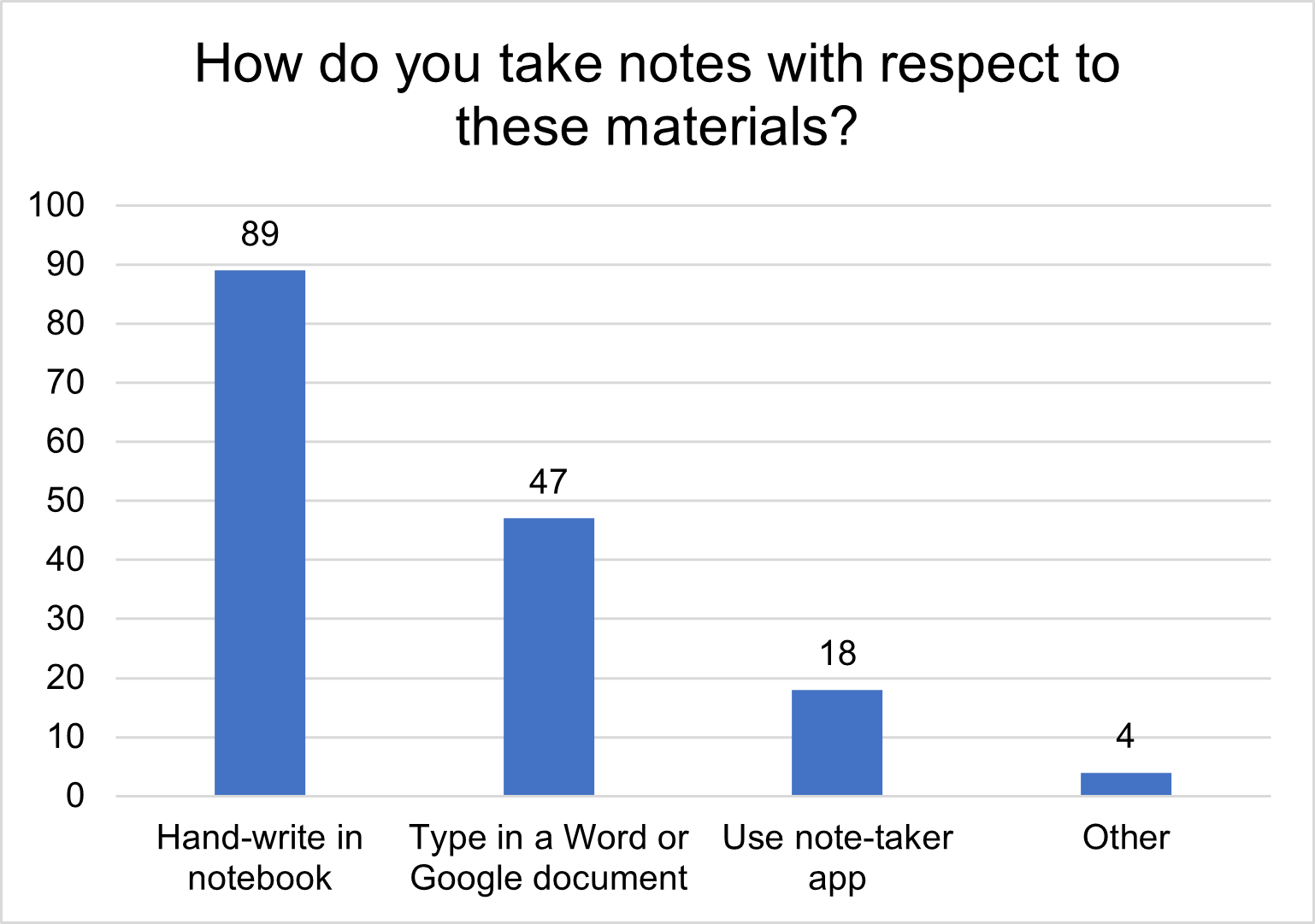
More ZTC/LTC courses in Spring 2023
We asked students whether they were planning on taking more ZTC/LTC courses in the subsequent Spring 2023 semester. Fifty-eight percent indicated that they definitely would be taking more ZTC/LTC courses, with another 34% indicating that they might do so. These data can be seen in Figure 3 below. When asked for reasons, overwhelmingly students indicated that the cost of instructional materials played a significant factor in their decisions, whether they were using financial aid funds or not. Some indicated that the OER-based materials were more interesting or more engaging than traditional materials.
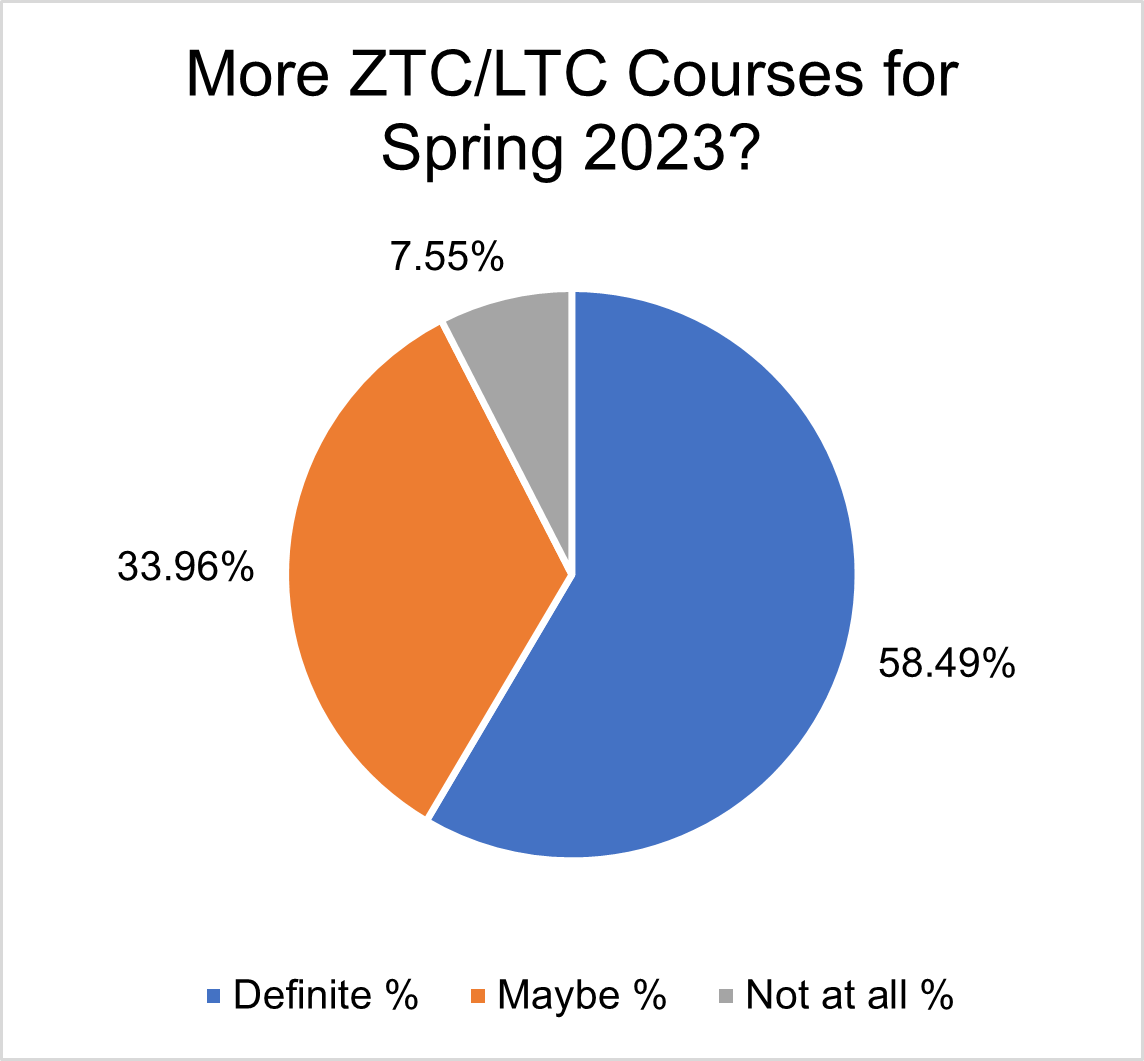
Recommendation of ZTC/LTC courses
The TAS inquired whether current ZTC/LTC students would recommend these courses to other students. By a significant margin (71%), students would definitely recommend ZTC and LTC courses to fellow students, with another 26% indicating that they might do so. These data can be seen in Figure 4 below. Among the reasons cited, students indicated that the high cost of course materials and access to education being the chief reasons for recommending these courses.
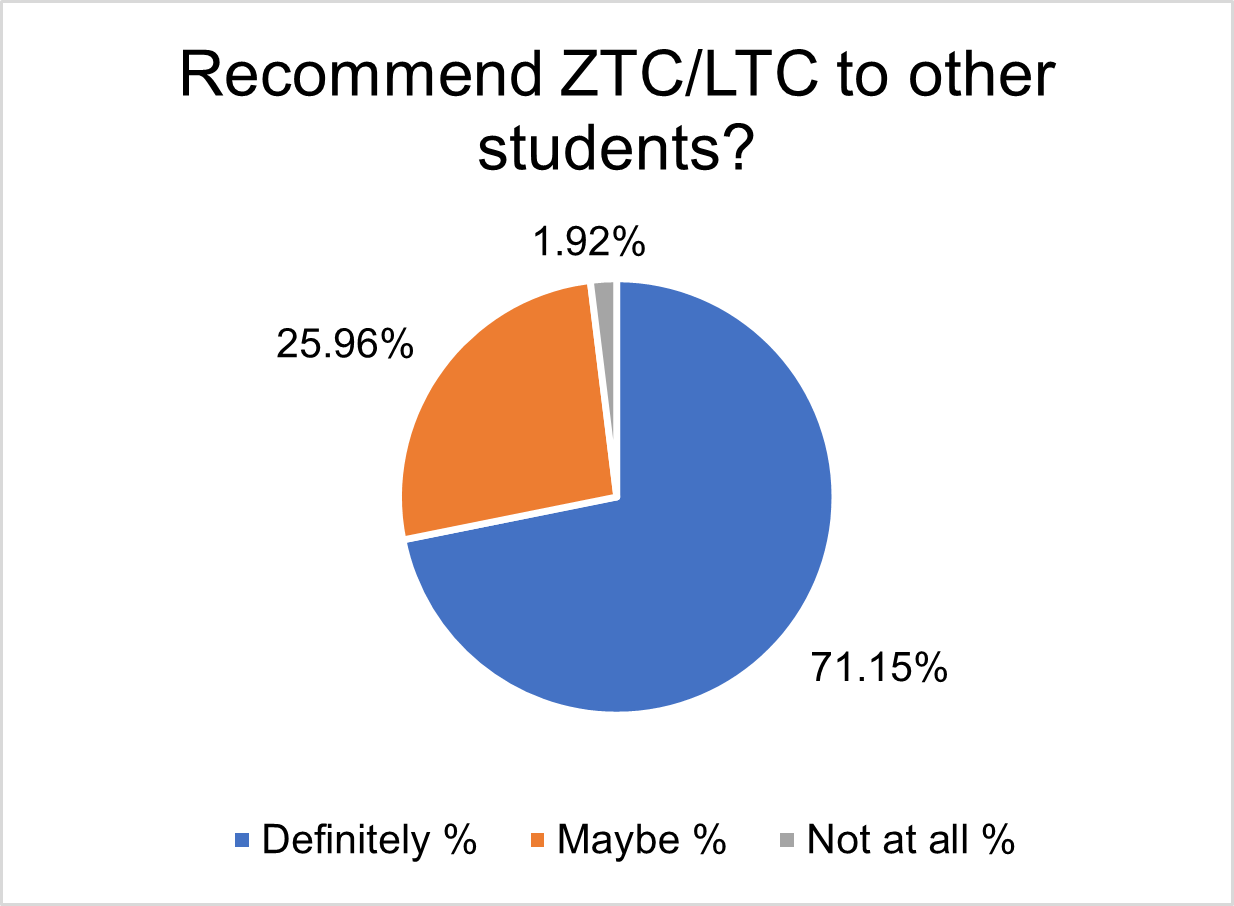
Subsequent Inquiry
Based on the information culled from the Fall 2022 student survey, as well as anecdotal information from students and faculty, the TAS had the following research questions:
- What are the enrollment trends for ZTC/LTC courses and sections versus others?
- What are the success and retention data for ZTC/LTC courses and sections versus others?
- What trends can we see, starting from Spring 2021 through Fall 2023?
To that end, the Cañada Planning, Research and Institutional Effectiveness (PRIE) Office offered enrollment data from Spring 2021 through Fall 2023 as a way to measure enrollment trends. They also provided disaggregated retention and success data for ZTC and LTC sections from that time period. What follows in the next two sections is the analysis and discussion of those data.
Enrollment Trends: Who Is Walking the Trail?
Cañada College’s faculty and staff have focused on enrollment trends for various types of courses and various cohorts as a regular part of program review. As the college is in the process of evaluating its current Educational Master Plan and identifying new goals for the next planning cycle, analyzing enrollment trends will help in identifying both effective practices and gaps that need to be addressed.
For ZTC/LTC courses, the research question was simple: Were there any trends involving ZTC/LTC courses between Fall 2020 and Fall 2023? Cañada’s PRIE Office offered enrollment data for ZTC/LTC courses versus all other courses for that time period. While there were some slightly higher enrollment gains in ZTC/LTC sections versus all other sections in the 29-60 days before the section start date (25.5% versus 23.6%), as well as during the add/drop period after the section start date (10.0% versus 9.2%), there is overall little statistical difference in the data. These data can be seen below in Figure 5 below.

Given that the San Mateo County Community College District and its three colleges (Skyline College, the College of San Mateo, Cañada College) were asking similar questions with respect to enrollment trends, the PRIE Offices in the district created a Tableau-based SMCCCD ZTC Dashboard in February 2024. Data from the Summer 2020 term onwards are captured in this tracker, which also includes disaggregation by college, course, academic division, cohort, student demographics and other major metrics. The tool has helped the ZTC leads on all three campuses track important enrollment metrics in an easy and automated fashion.
The data indicate that the enrollment rate at Cañada is essentially the same between ZTC/LTC sections and other sections. It should be noted, however, that the date by which faculty submit their textbook adoptions is a crucial element. While due dates were announced regularly to faculty, there had been consistent late textbook adoption submissions, including after the start of registration for the period. This, in turn, meant that many courses could not be labeled for textbook options, including whether they are ZTC or LTC, until after students had already mapped out their course plan and registered for courses. When these equity-based issues were discussed in participatory governance meetings, the faculty observed that they needed to submit their adoptions earlier. As a result, 90% of all courses for Summer 2024 and Fall 2024 had textbook adoptions entered on-time, leading to accurate labeling of ZTC and LTC courses in the online schedule before registration opened for each term. For Spring 2025, 95% of all courses had their adoptions in on-time. This increase was due to multiple levels of outreach by the Bookstore Manager and the OER/ZTC Coordinator in coordination with academic deans.
Success and Retention: How Is the Trail Going?
Cañada College, like most California community colleges, follows the RP Group’s definitions for college metrics. In this case, the definitions of success and retention. While Cañada College had anecdotal information about success and retention of students in ZTC and LTC courses, the results of the data request from PRIE showed interesting insight into the experience of the students.
Comparing Pandemic-Era and Post-Pandemic-Era Data
It should be noted that the terms that are covered in the PRIE Office data include both pandemic-era (Spring 2021 through Summer 2022) and post-pandemic-era (Fall 2022 through Fall 2023) results[6]. The TAS felt that it would be important to compare initial success and retention rates for ZTC/LTC sections as compared to all other sections, since there were a number of efforts to ensure that students had access to the technology needed to complete their coursework. As can be seen in Figure 6 below, there were improvements in ZTC/LTC sections from Spring 2021 through Fall 2021, but that Spring 2022 and Summer 2022 showed some changes in the other direction. Yet, as can be seen in Figure 7 below, by the time the Post-Pandemic Era starts, there is little-to-no statistical difference between ZTC/LTC sections and all other sections. This suggests that by the time the college entered Fall 2022, students were becoming more familiar with the technology used in those courses.

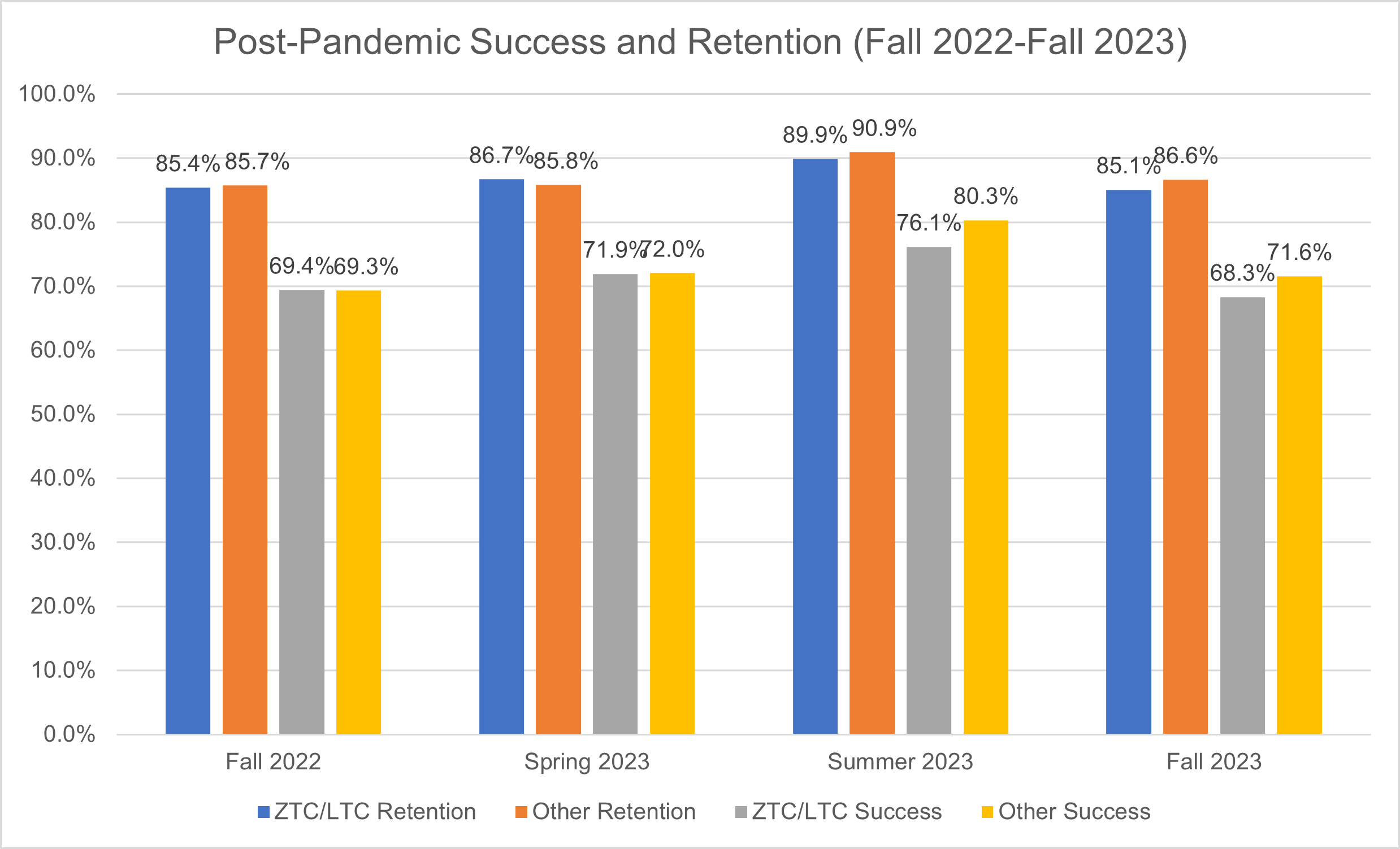
Comparing by Disaggregated Student Data
With these data points in mind, the TAS asked how success and retention in ZTC and LTC sections compared with respect to various disaggregation metrics. The idea was to identify potential gaps, particularly with respect to ethnic and socio-economic groups that are known areas of need.
Like most higher education institutions, Cañada College and its PRIE Office publicly shows various college metrics, including success and retention rates for various disaggregated cohorts. The college’s PRIE Disproportional Impact (DI) data dashboard shows that information for a number of academic years. As the data for this program review report ran through the Fall 2023 semester, the groups that were considered to be disproportionally impacted were based on the 2023-2024 academic year; they are as follows, with their 2023-2024 headcounts in parentheses[7]:
- Black (Non-Hispanic) (286)
- Hispanic/Latinx (4,470)
- Pacific Islander (137)
- Filipinx (587)
It should be noted that Cañada College has been officially recognized as a Hispanic Serving Institution (HSI) since Fall 2012, and an Asian American, Native American and Pacific Islander Serving Institution (AANAPISI) since Fall 2022. As such, reviewing the disaggregated ethnic data is of vital importance in any data analysis of college metrics. Additionally, the college lies in one of the most affluent regions of the country, yet has a significant sector of the population who are of middle-low or low socioeconomic status; as a result, the college and the district work to identify and address known gaps to service the entire community.
When disaggregated for ethnicity, the success (Figure 8) and retention (Figure 9) rates were similar between ZTC/LTC sections and all other sections. When focusing on the DI areas of focus, there was improvement in ZTC/LTC courses for Black Non-Hispanic students, while rates for Hispanic and Filipino students showing no statistical difference between ZTC/LTC sections and all other sections.


The same story unfolds when analyzing the data for other college metrics. Retention (Figure 10) and success (Figure 11) rates disaggregated for gender showed similarities, with ZTC/LTC section data being statistically similar to the college data.
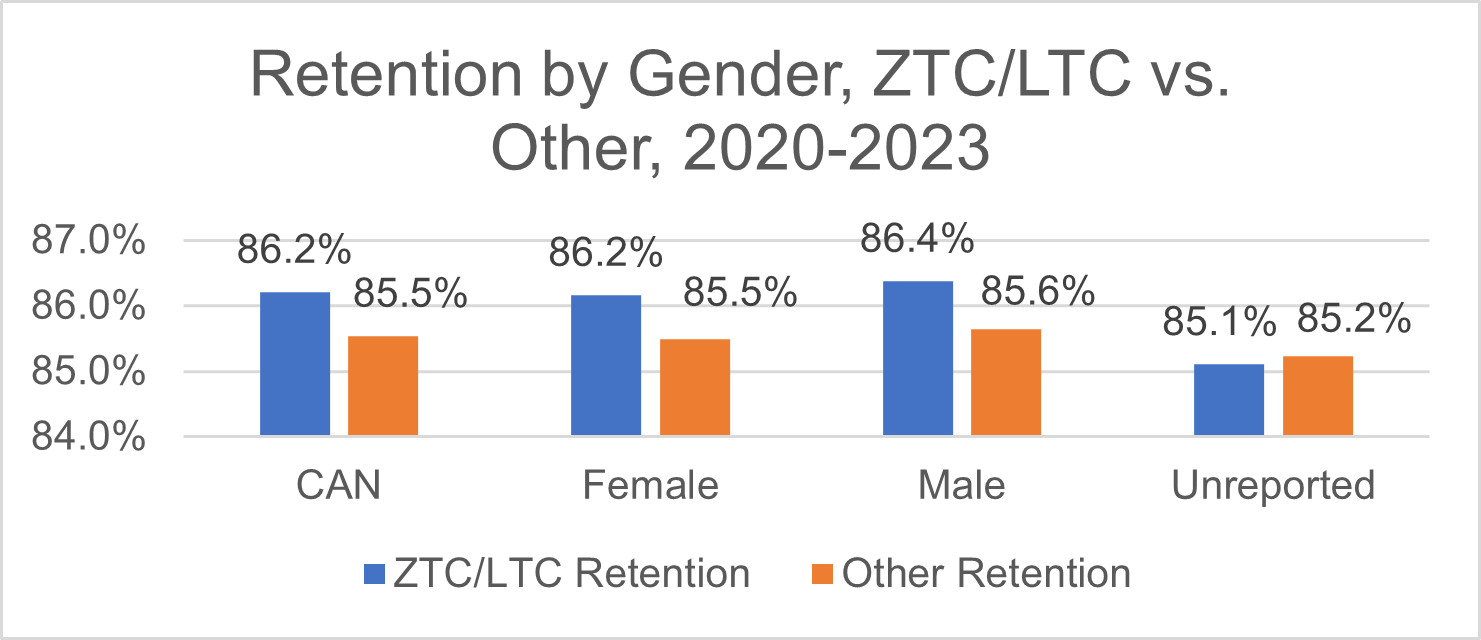
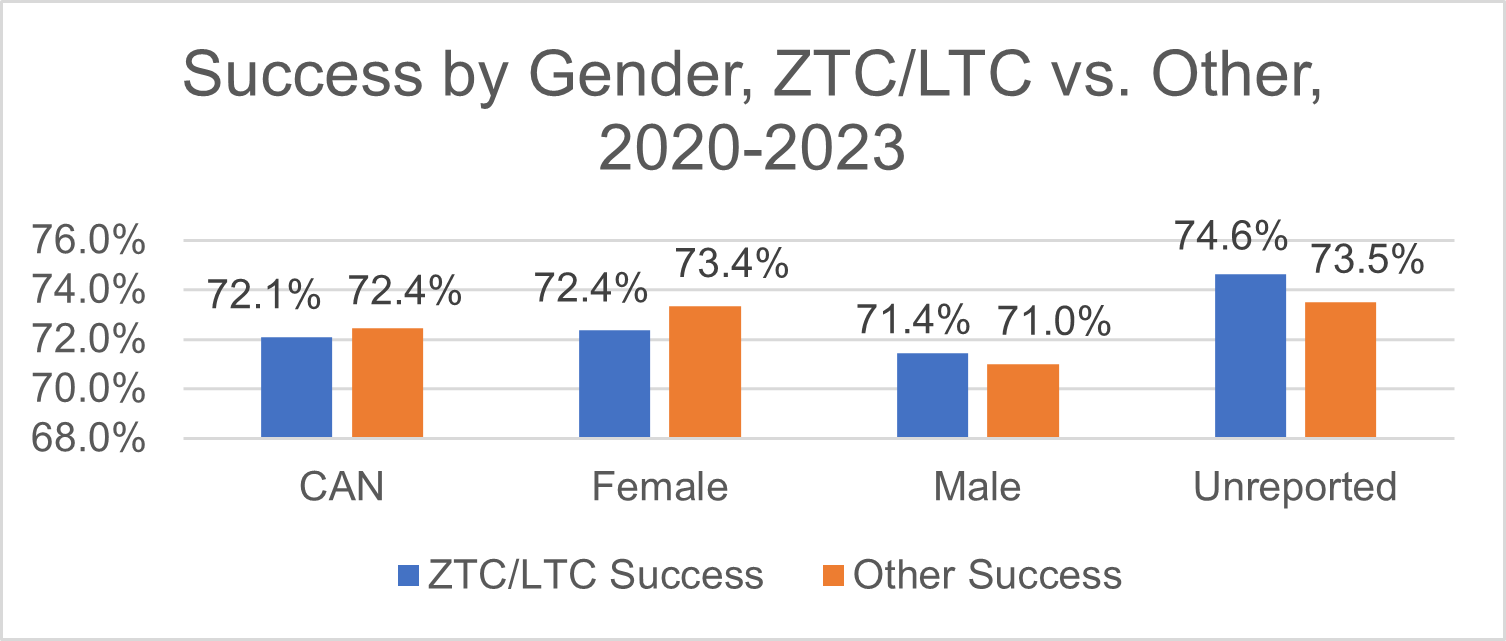
In fact, the same statistical similarity can be seen when the data are disaggregated for income[8] (Figure 12 and Figure 13), first generation students (Figure 14 and Figure 15), and whether students were enrolled in the college’s Promise Scholars Program[9] (Figure 16 and Figure 17).
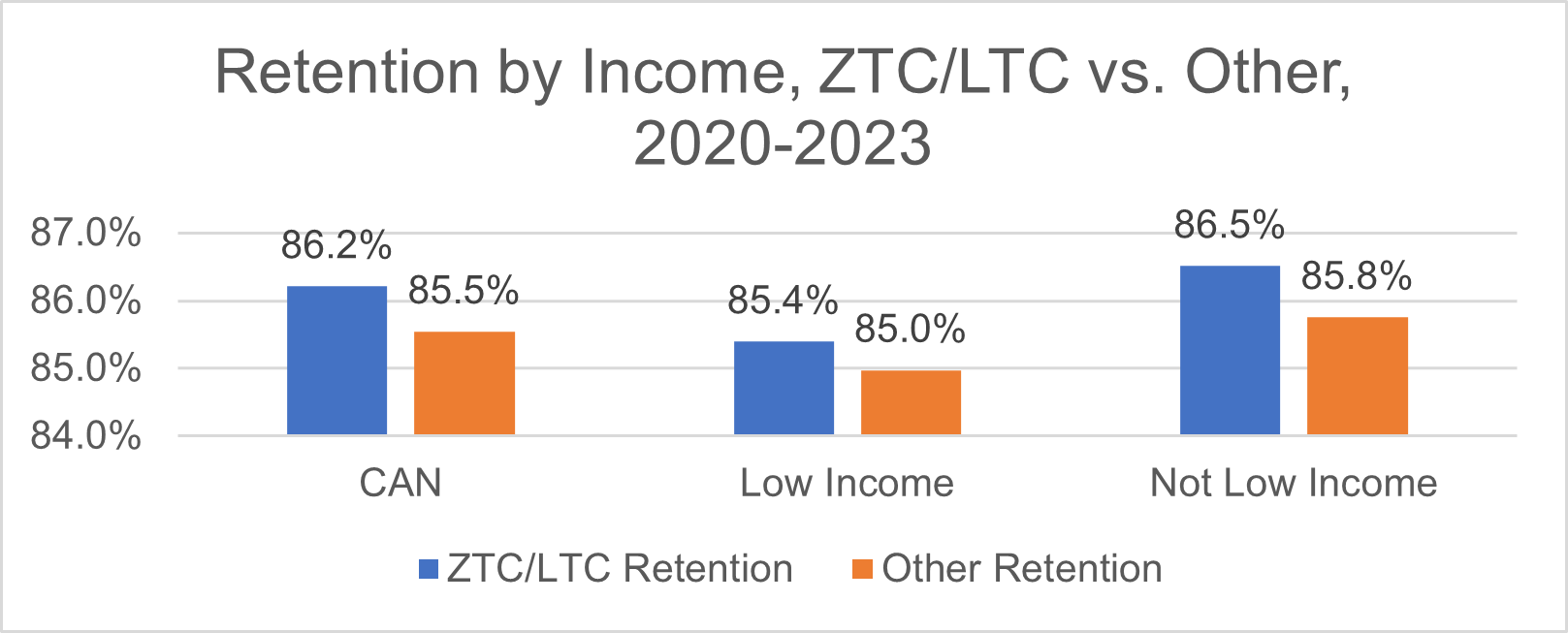
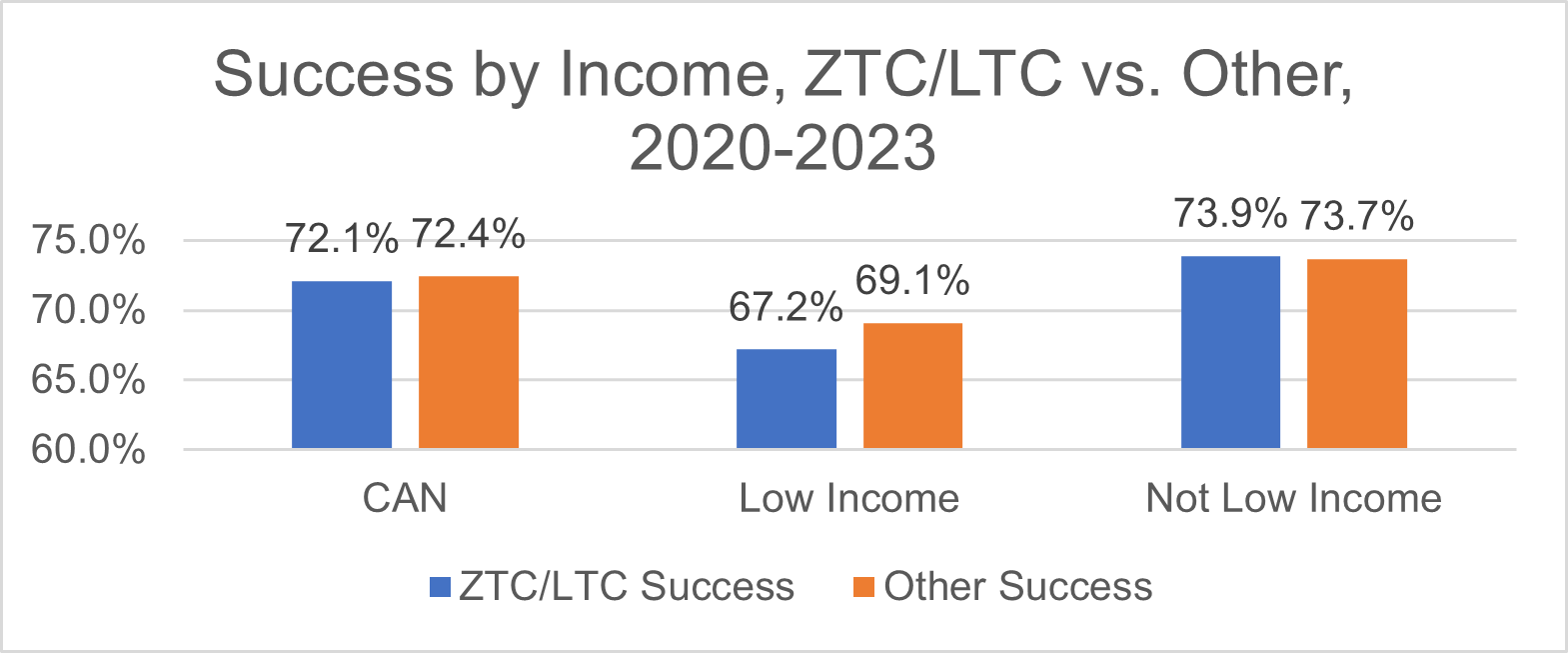
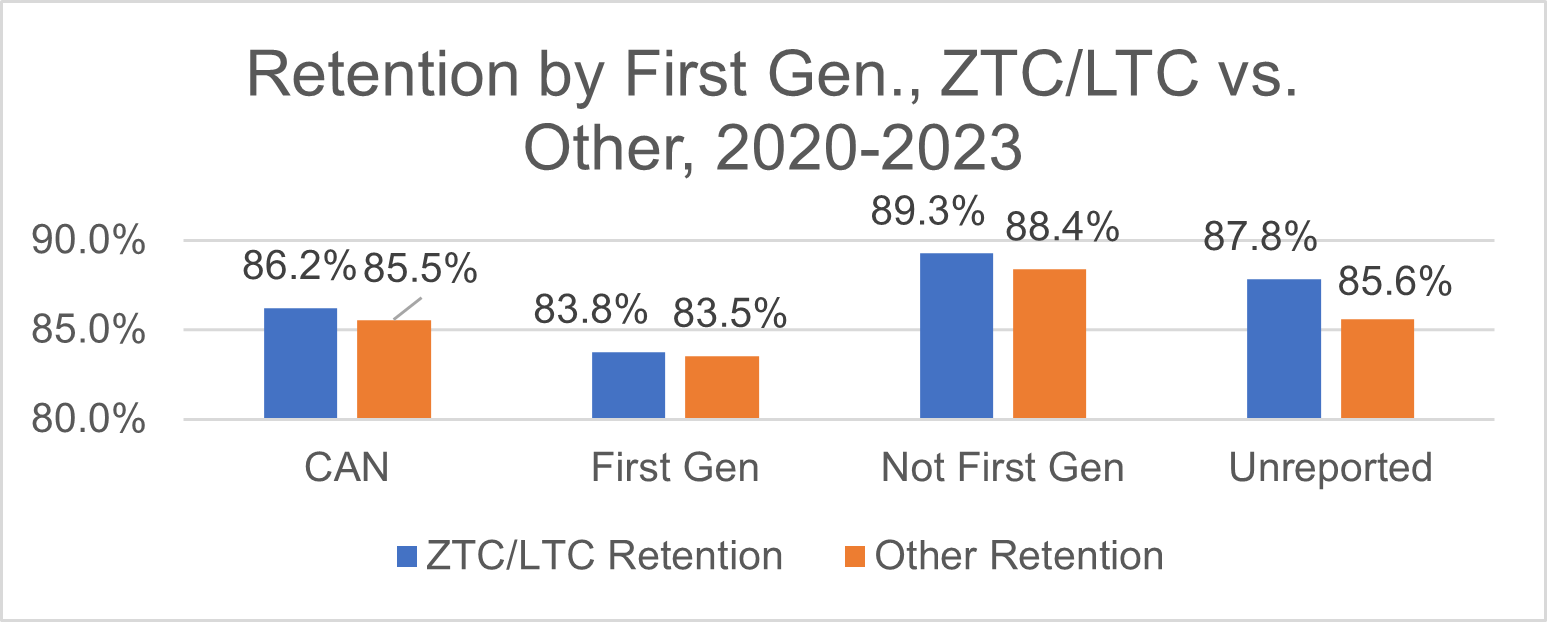
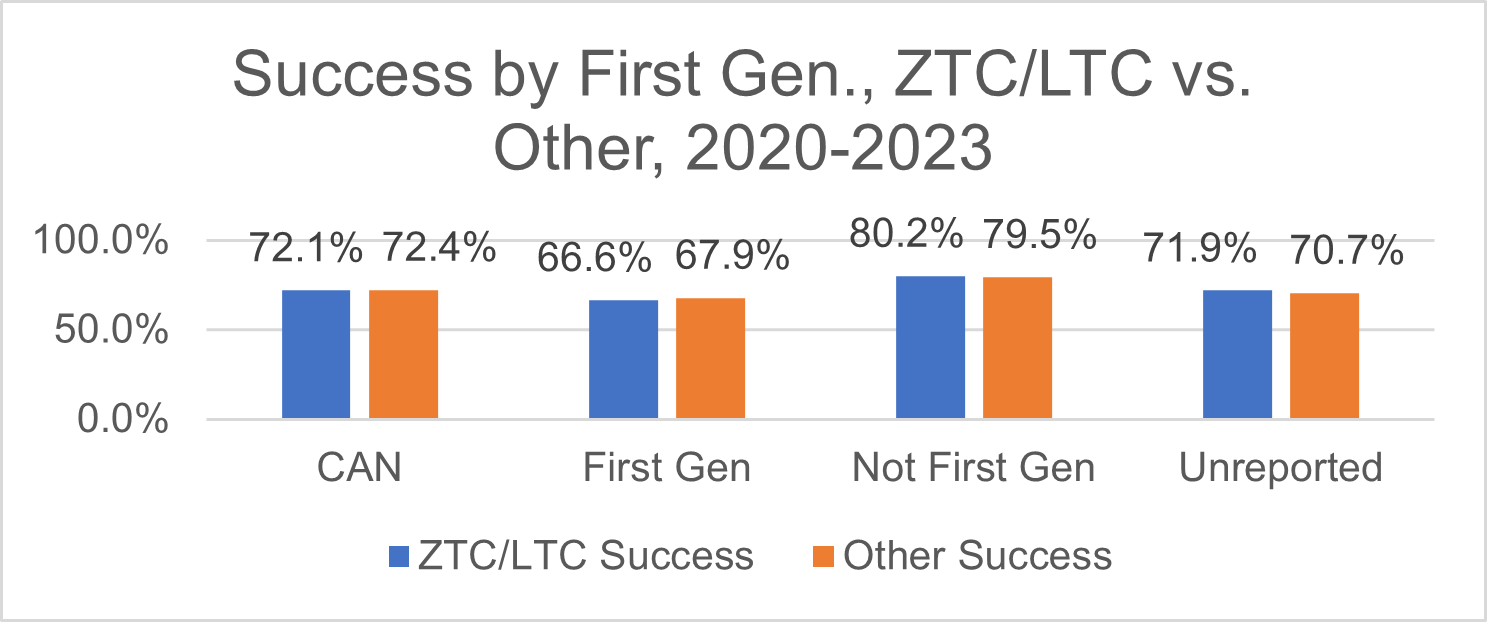
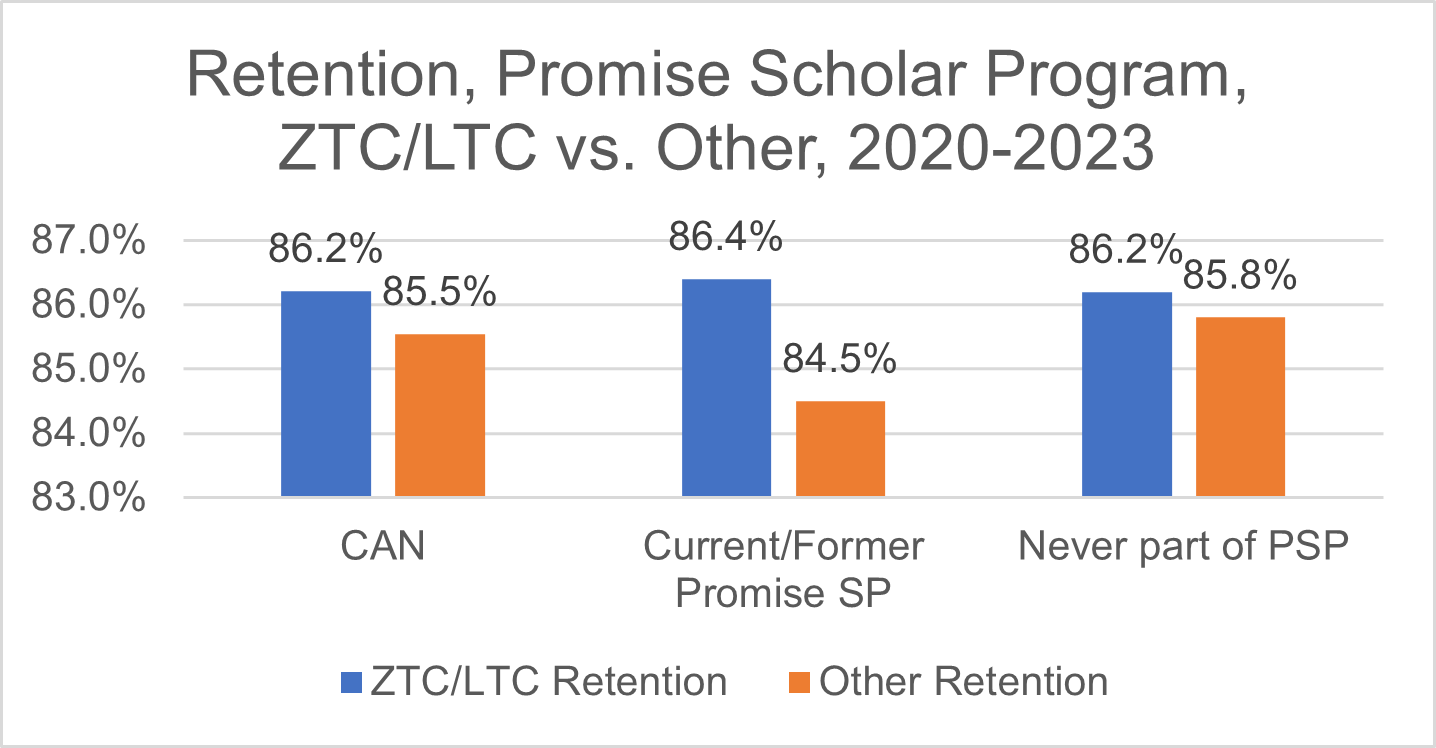
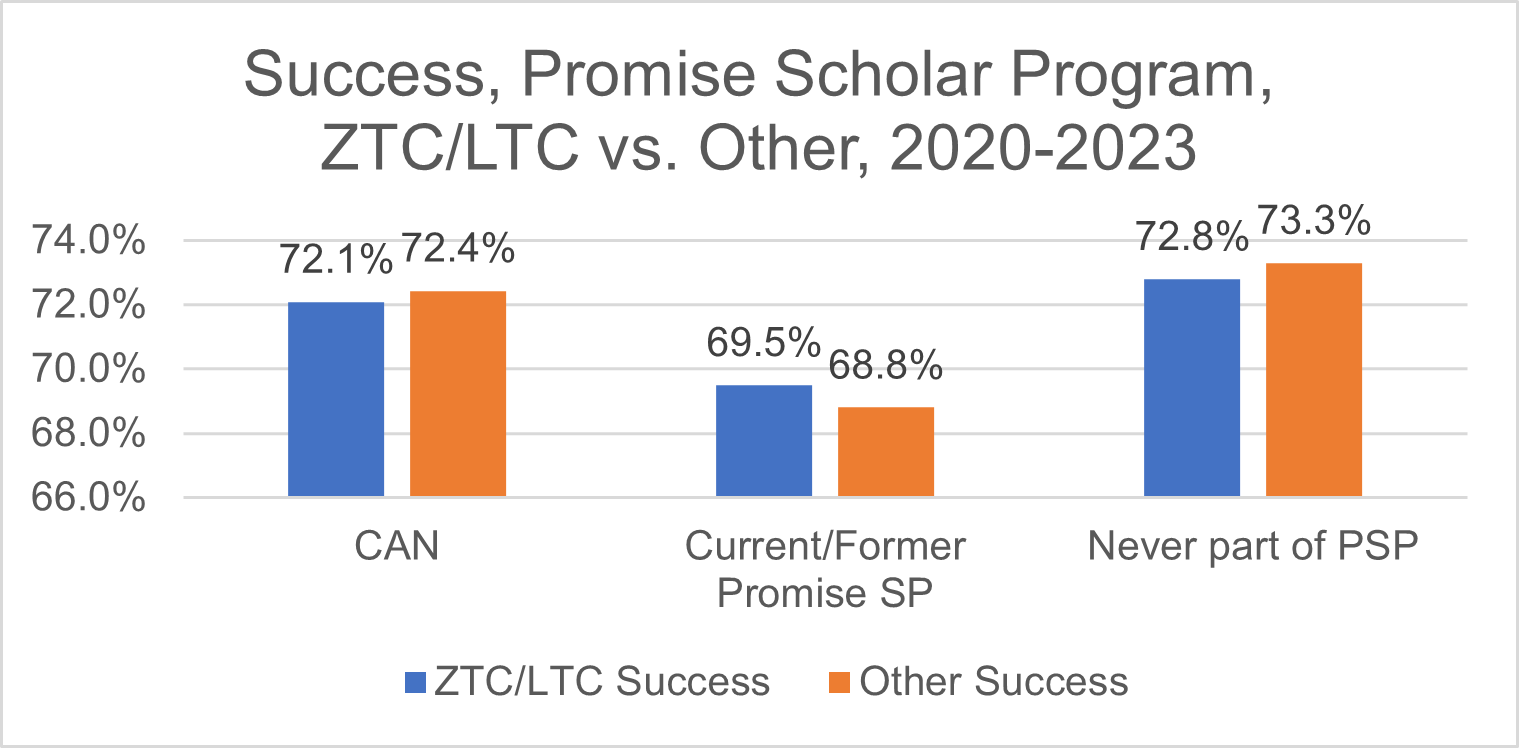
As the TAS and the greater college community reviewed these data, the primary take-away was clear: ZTC/LTC sections showed themselves to be at least equal to those sections using traditional publisher-based materials—and in some cases, there may be benefits to certain DI populations. As qualitative inquiry continued into the data, there seemed to be a particular emphasis on those programs where there were additional academic support programs offered to students, such as Umoja (an African American affinity group) and Promise Scholars Program.
Finishing the Trail and Looking for the Next Trail
After analyzing the data from the Fall 2022 ZTC/LTC Student Survey and the program review data provided by PRIE, and in conjunction with various presentations of these data, the TAS looked to address the gaps that were highlighted in the data trends. Additionally, they made recommendations and sought to create new pathways and partnerships to address student needs.
Addressing Enrollment
The key element identified in addressing enrollment was to increase awareness among both faculty, students, and other support staff. The idea was and is simple: The more that people know about ZTC/LTC courses, the more they will ‘see’ them in the various places that are accessed to find out information about courses.
First and foremost, the TAS identified the need for faculty to submit their textbook adoptions on-time and completely. The information could then be entered into Banner, the district’s scheduling and infrastructure system, thereby updating the public version of the schedule in a timely fashion. This would allow students to know more about the different sections of courses in time to plan out their course schedules and ahead of the main enrollment period.
Faculty had indicated that part of the issue was how they submitted their textbook adoptions, that there were too many steps to get that information into a variety of people. As a result, the OER/ZTC Coordinator and the Bookstore Manager worked together to streamline the reporting process, with the coordinator directly working with known ZTC and LTC faculty once the final schedule of courses was inputted into Banner. The Coordinator did further outreach to new faculty as soon as they were assigned courses for courses that were already identified as ZTC or LTC, and materials were shared early in this process so that adoptions could be sent in as soon as possible. Given that Cañada College offers approximately 400-600 sections per term, this process has been a manageable one for two people to work on. While there was still manual updating to be done, this early communication and cross-checking between the OER/ZTC Coordinator and the Bookstore Manager allowed 40% of faculty to be able to submit their adoptions automatically and the ZTC or LTC attributes placed on their course listings ahead of the enrollment period.
This new process was unveiled in various division and department meetings and in the New Employee Orientation; as a result, faculty adoptions for Summer 2023 and onward came in on-time and 90-100% complete. As a result, the publicly-facing schedule of courses had accurate information about ZTC and LTC courses early enough so that students knew about their choices as they were registering for courses. Correlatedly, enrollment in ZTC and LTC sections for Summer 2023 onwards has grown, not only due to the increased number of sections. Continued work in this area hopes to automate some of the reporting process, thereby improving reporting efficiency and accuracy.
Addressing Awareness
The next element to address was an increased awareness. Having the ZTC/LTC icons on the publicly-facing course schedule could only be effective if few people knew to look for those icons in the first place. As a result, the TAS started their outreach campaigns on campus and in the community. The Cañada College ZTC webpage was initially created to share basic information about ZTC and LTC courses, supplemented with information that had been pulled together from various presentations around campus. They created flyers and bookmarks as promotional materials starting Fall 2023. In Fall 2024, the OER/ZTC Coordinator was able to hire a student assistant with a background in multimedia and digital art to create ZTC/LTC explainer videos in English and in Spanish; these videos are showcased on the refreshed ZTC webpage, and they have been shared by the college’s social media accounts. The OER/ZTC Coordinator[10] continues to make presentations at the Associated Students meetings to increase awareness, and ZTC/LTC courses are a part of planning in a number of departments. Finally, the promotional materials are used by the Promise Scholars Program, the Outreach department, and the Umoja program as they recruit students and connect with the community at large. As the California Community Colleges Chancellor’s Office created ZTC funding to create pathways at each college, Cañada College has taken those funds and created a number of pathways in both traditional and career/technical disciplines to highlight to the students and the community their commitment to addressing significant barriers to students and their educational goals. The message is clear: Cañada College is using ZTC/LTC as means to include everyone in attaining their educational goals.
Addressing Success and Retention
While the data on success and retention showed that ZTC and LTC sections ‘did no harm’ to students, the TAS felt that more could be done to address the known gaps and those that arose in the reports. To this end, they looked to campus partners to address students’ needs.
Focusing on the DI groups (Black Non-Hispanic students, Hispanic students, Pacific Islander and Filipino students), the TAS felt it was important to make strong connections to the cohorted programs that connect with those populations. As a result, there was increased conversations with the leaders of Umoja (an African American affinity group) and Puente (a Hispanic affinity group); this was of particular import as both programs focus on barriers involving representation and access to materials. Given that OER are able to be customized to fit student needs and to make the instructional material more representative of the student population, faculty who taught courses associated with both programs looked to adopt or adapt existing materials to better fit their needs. Additionally, both Umoja and Puente focus their teaching practices on pedagogical and andragogical methods that include students in the learning process, something that resonates with many of the tenets of Open Pedagogy. With continued dialogue, both programs are looking to expand their ZTC and LTC offerings.
Closing the digital gaps was identified as an area of need; if students are not comfortable using digital materials, then moving to ZTC or LTC course materials will continue being a barrier. As a result, the OER/ZTC Coordinator worked with the college’s Learning Center to create workshops for students to teach them how to use various types of digital materials, including OER and library-based materials. They added to the Canvas workshops to guide students in how to interact with these and other materials that are used in their courses. Finally, the college identified more funding for the library’s Technology Loan Program, allowing them to lend out more laptops and internet hot spots to students. By addressing the gaps, the success and retention rates are expected to increase, both for ZTC/LTC sections and the college overall.
Addressing Professional Development
The follow-up discussions of the various data sets showed a clear need for increased professional development for faculty and the campus community on topics related to ZTC/LTC course materials. As a result, the OER/ZTC Coordinator worked with the college librarians to create a workshop presentation on Fair Use, copyright and the importance of Creative Commons. This presentation is being modified to present to students the library’s regular rotation of workshops.
As the college continues to review processes, there has been consistent conversation of intentionally incorporating the ZTC Adopter Program into the larger professional development landscape. This is being done as a way to institutionalize the program and to recognize it as important work for faculty to engage in, thereby connecting faculty who enter into that program with resources that can address equity and accessibility. This work is being done in conjunction with both the Professional Development Planning Committee and the Equity and Anti-Racism Planning Council. It has led to OER/ZTC projects that address competency-based grading practices, increased accessibility reviews for projects and the incorporation of digital literacy into curriculum.
This work is part of a larger, college-wide focus on equity, diversity, inclusion and anti-racism, allowing everyone on the campus to engage in critical and important conversations about the students and the community. The ideas expressed by the TAS tie into the greater conversations on the importance of how faculty teach and where the students are—the continued importance of meeting their needs and helping them to advance in their lives and educational goals. To this end, the TAS is looking to create continued and expanded partnerships with various stakeholders and groups on campus, including the Disabilities Resource Center, the Distance Education Advisory Committee and the Faculty Teaching and Learning Center and Lounge. This will require continued funding from internal and external sources and connections with other related topics (e.g. artificial intelligence), which the college leadership has indicated is in the plans.
How Other Colleges Can Mark Their Own Trails
This case study offers just one example of one college’s forays into OER/ZTC work. As indicated in the outset, this is not meant to be a perfect trail to follow; each college has its unique hills and valleys to traverse. Rather, we wish to showcase our journey as an example of a good hike, one that offers many wonderful views of the landscape and yet offers up plenty of barriers to overcome.
It is from Cañada College’s experience that the TAS offers the following suggestions and supports:
- Faculty buy-in from the start, particularly from Academic Senate: This work cannot be done without the faculty. In California’s community colleges, anything involving curriculum (including instructional material selection) is part of the faculty’s 10 + 1 rights, which has been codified into California Education Code. As a result, by getting faculty buy-in on anything having to do with OER or ZTC work, a program can ensure that there will be support overall by the college. Additionally, the more that these discussions can happen at the Academic Senate (or equivalent participatory governance body), including the creation of subcommittees and/or resolutions, the more weight goes behind these types of efforts
- Connections with students at regular intervals: Equally important is the need to include student voice at every juncture. Student surveys can go a long way, but equally important is to regularly inform the student body on efforts. In this way, we can listen to their needs and communicate important information to them.
- Support from administrators, particularly for faculty release time and/or stipends: In order to do this work and to do it well, faculty need time to create and revise materials. Getting administrators involved early and often allows that to happen. It also can help to increase involvement of faculty from all ranks and backgrounds; administrators can often spread messages farther than any email can.
- Collaboration with and involvement of classified staff who are intricately connected with student needs: This is an area that does not often get mentioned, but it is crucial in addressing student needs. Classroom-based faculty think they know what their students need; the various support faculty and staff are the ones that hear the comments from students and the messages that they want to send. By connecting with classified staff who work in these support programs, OER/ZTC programs can increase the communication in both directions, resulting in a richer learning environment for everyone.
If there is a theme in our recommendations, it is this: Support, support, support! Break down the silos that prevent ideas from flowing across the campus, and support your colleagues and the campus community in addressing all of the barriers that students face. The more that a college does this, the more it can help everyone get to where they need to go.
Acknowledgements
As the TAS and the OER/ZTC Coordinator collected and analyzed the data presented in this case study, it became clear that an immense amount of gratitude is owed to the following people at Cañada College:
- ZTC Adopter Program participants, of which there have been 23 faculty representing 12 disciplines through the Spring 2025 cohort.
- Disciplines that have significantly moved to ZTC at Cañada College, which include Anthropology, Business, Chemistry, Communication Studies, Education and Human Development, Mathematics, Physics, and Political Science.
- Student Support folks who have connected with students—a list which is too long to write here, but includes every sector of our campus.
- Finally, a huge amount of gratitude is owed to Prof. Marco Seiferle-Valencia of the University of Idaho for his comments and questions as he reviewed this chapter.
- Student enrollment is a duplicated metric; students are counted once per course enrollment and may appear multiple times across terms or within a single term. ↵
- ZTC estimated savings are $100 per student per section, while LTC estimated savings are $50 per student per section. ↵
- Cross-listed sections are counted as one instead of separately in these metrics. ↵
- Part-time students take between 6 and 12 units per semester; less-than-part-time students take less than 6 units per semester. ↵
- This position is not compensated at the college; ASCCC provides a $500 stipend per semester for the liaison. ↵
- This definition is based on the fact that in-person and hybrid modalities were able to come back to campus starting in Fall 2022 for all courses. Prior to that term, only a limited number of courses were allowed to have an on-campus presence due to the Covid-19 pandemic ↵
- For reference, the total Fall 2023 headcount was 6,409 students. ↵
- Low-income students are measured based on their reported income on their FAFSA and includes Pell Grant eligibility, BOG/California College Promise Grant recipients, and self-reported income. ↵
- The Cañada College Promise Scholars Program are those who are either current or former participants of the Cañada College Promise Scholars Program, which is the primary need-based cohort for the San Mateo County Community College District. ↵
- Starting Fall 2025, this faculty coordinator position has been transformed into a full-time OER/ZTC Program Manager position, which is a supervisory role. The OER/ZTC Coordinator position has been left unstaffed and put on hold until further notice. ↵

